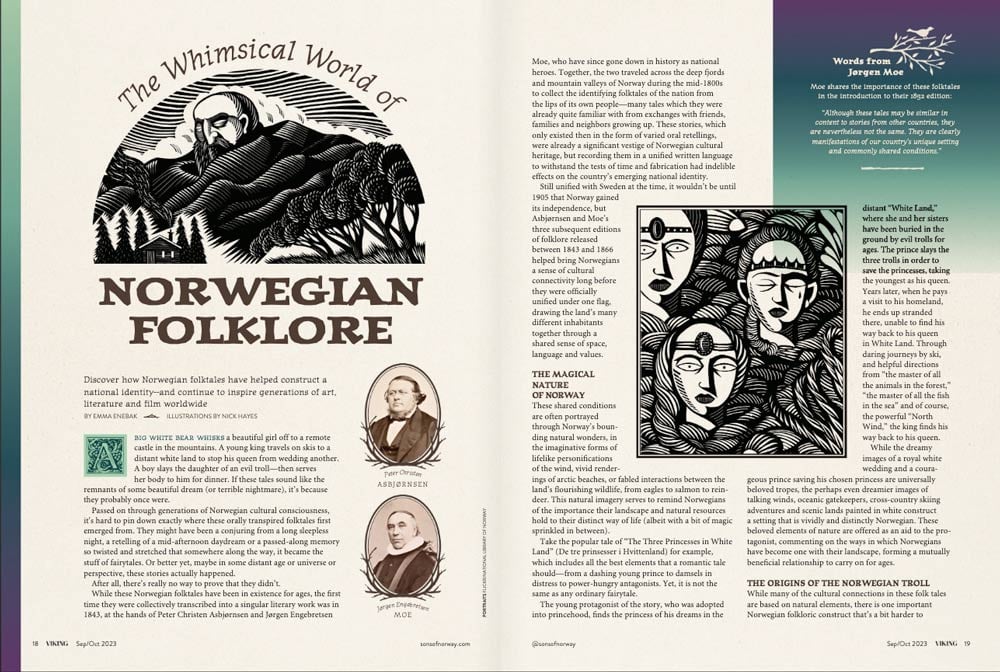In the Sept/October issue of Viking magazine, Emma Enebak recounts the Whimsical World of Norwegian Folklore, and some of the fairy tales collected by Asbjørnsen og Moe.
Unlike the famed German Brothers Grimm, Asbjørnsen and Moe themselves went out to the far corners of Norway to collect the stories of their people, and hence much of the local color remained intact, causing the Norwegian people to preserve and bolster their national identity in a period when they were still under Swedish rule.
The stories they collected are known as folkeeventyr – folk tales, which are an oral tradition with no known author. Another characteristic of these tales is that they are set in no specific time or place, only vaguely referring to “once upon a time,” or “east of the sun and west of the moon” as their setting.
Similar to fairy tales from other cultures, Norwegian eventyr make use of archetypes – a standard set of characters representing good and evil, for example the underdog Askeladden (the Ash Lad), the princess, the troll, the king, the old woman. In some cases, a person has been turned into an animal, a young person disguised as old, or a huldra (female troll) masquerades as a human.
As in English fables, Norwegian folk tales also make use of several fixed expressions:
- Det var en gang (en/et) – Once upon a time / There once was a…
- Og rett som det var – Just then
- i et land langt, langt borte – in a land far, far away
- over berg og blåne – over hill and dale
- langt og lengre enn langt – far and longer than far
- Snipp, snapp, snute, så er eventyret ute – Snip, snap, snout, now the story is out.
(In English we of course have “And they all lived happily ever after” as the classic fairy tale ending.
It is common for a refrain to repeat over and over throughout the folk tale. In the Norwegian story of Pannekaka (The Pancake), the repeated line is “Kjære mi pannekake, trill ikke så fort, bli litt og la meg få ete deg,” My dear pancake, don’t roll so fast- stay a while, so I can eat you!”
This bears a mirrored resemblance to the refrain “Run, run, run as fast as you can, you’ll never catch me, I’m the Gingerbread Man!” In fact, the English fairy tale and versions from other cultures are based on retellings of Asbjørnsen and Moe’s folktale. And as it turns out, both the Pancake and the Gingerbread Man suffer the same fate.
Watch the video of Pannekaka and follow along with the subtitles- you don’t need to know Norwegian to see that the text repeats certain passages. See if you can also spot “Og rett som det var” being used over and over. Listen for the fun rhyming pairs such as kone-krone, mann-brann, høne-pøne, hane-pane, gasse-vasse, etc.
Another oft-used device is that of magic numbers, often appearing in threes and sevens, as well as talking animals:
- De tre bukkene bruse- The Three Billy Goats Gruff
In this classic tale, the goats range from the minste/smallest, to the mellomste/middlest, to the største/biggest, who finally does battle with the troll. Battles against trolls often have gruesome results, with the troll suffering a harsh fate to emphasize the triumph of good over evil. - Askeladden and his brothers (Per, Pål og Espen Askeladd, also called Nyvil, Pøk og Oskefis in certain regions) The older brothers play the archetype of Everyman, but they are selfish and don’t help others when they can. Askeladden, small as he is, overcomes the troll on the basis of his wits bringing the king the seven silver ducks.
Lastly, there may also be a moral of the story – meant to highlight shared values and reinforce doing the right thing. Some of these include:
- Might and riches don’t always win
- The spirit of the underdog / cleverness can triumph over evil and power
- Being self-absorbed doesn’t get you far in life
- Helping those in need is its own reward, but could also win you the princess and half a kingdom
- Conflict can be resolved through kindness, intelligence and/or courage
Unlike his brothers, Askeladden always shares what he’s got, even if it means that he has to give away the last thing he has. Towards the end of the story, it often turns out that the poor man or old woman was not so poor or helpless after all, but rather becomes an important helper and contributes to Askeladden’s eventual success.
For more details on the folklore documented by Asbjørnsen and Moe, log into sofn.com and read the digital issue of the Sept/Oct 2023 Viking here.

